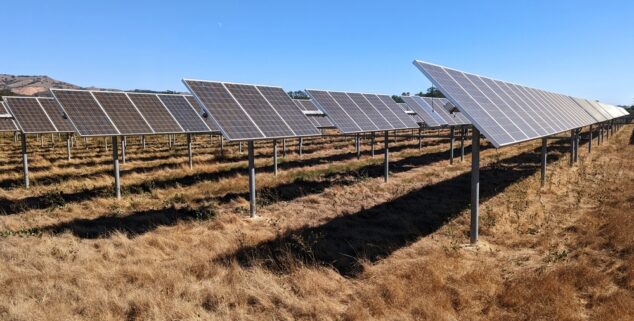Opinion
California needs more community solar. A lot more.
 Solar farm in Napa, CA. Image by Noah Sauve
Solar farm in Napa, CA. Image by Noah SauveOPINION – Leading the way is nothing new to Californians. Not only does California lead the country in clean energy, we’re also the fifth-largest economy in the world and a hub of global technological innovation. But we now face the same increasingly strong headwinds as other parts of the country – addressing housing, climate, and affordability crises all at the same time.
Our state’s ambitious residential building efficiency standards solve one half of the equation, by requiring renewable energy to power them. Yet, these new requirements cannot be fulfilled unless all forms of solar are accessible and expanded. The state’s utility regulator has an opportunity to tackle housing costs and energy affordability challenges all while enhancing the state’s leading efforts at addressing climate change. California must take all necessary steps to expedite that access by adopting strong community solar plus storage program design.
Five years ago, California became the global vanguard in building efficiency standards, on top of its already industry-leading status, by requiring all new construction to have solar energy systems installed. As the standards were being debated, I was often asked, “What about the buildings that are too tall? That are shaded by a tree? That don’t have a south-facing roof?” The good news is that a perfect answer to these questions exists: community solar. New homes could sign up with a solar project elsewhere in the community to provide clean energy and comply with the solar requirement. The state’s building code standard included community solar as an option for that very reason. Yet the only problem was, there is effectively no way to do community solar in the state.
Starting on January 1, 2020, the California Energy Commission’s (CEC) Residential Building Energy Efficiency Standards required all new homes to have rooftop solar or meet the renewable energy requirement using off-site, community solar. The CEC adopted minimum administrative requirements which must be met for a community solar farm to be certified for use in complying with the new solar mandate. However, the current Public Utility Commission Green Access Program options do not guarantee consistent savings for new homeowners who utilize community solar when complying with the CEC’s Energy Standards.
Five years ago, California became the global vanguard in building efficiency standards, on top of its already industry-leading status, by requiring all new construction to have solar energy systems installed….Yet the only problem was, there is effectively no way to do community solar in the state.
Our state’s homebuilders need a lot of community solar. Our team at the California Building Industry Association (CBIA) estimates that at least 250 to 450 MW of community solar facilities would be needed every year going forward to meet builders’ desire to utilize community solar as a compliance option for Title 24 requirements; that is enough solar for 40,000 to 90,000 homes every single year. Similar building requirements are expected to be expanded to public and commercial buildings during this decade to meet the expansion of the state’s solar on new construction goals, which will increase the need for viable off-site solar options.
The California Public Utilities Commission (CPUC) has been working on implementing Assemblymember Chris Wards’ bill, AB 2316, which the governor signed last September. With any luck, they’ll be done with their regulatory proceedings this fall. Our hope is that they adopt a community solar plus storage program that can meet the needs of homebuilders as well as bring clean energy to those who haven’t been able to access the clean energy revolution in the state.
Specifically, the CPUC should adopt the Coalition for Community Solar Access’s proposal that has the support of ratepayer advocates, labor, and environmental justice groups and is based on best practices from around the country. After ten years and two attempts, California now has a chance to set us on the right path for community solar and storage — the California Public Utilities Commission should take it.
Chris Ochoa is Senior Counsel for Codes, Regulatory, and Legislative Affairs at the California Building Industry Association
Want to see more stories like this? Sign up for The Roundup, the free daily newsletter about California politics from the editors of Capitol Weekly. Stay up to date on the news you need to know.
Sign up below, then look for a confirmation email in your inbox.

Leave a Reply